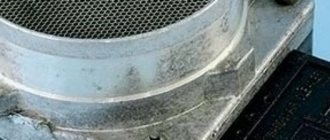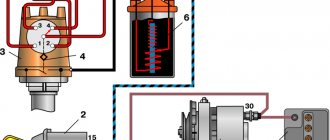Purpose
This spare part was not always part of the car. We owe its appearance to modern requirements for the environmental performance of cars, and to be more precise, the Lada Granta acquired an adsorber thanks to Euro-3.
(Euro-3 is an environmental standard that was introduced in 1999, but Russian manufacturers were able to meet its requirements only in 2008.)
The adsorber, for which Granta became one of the first “shelters” in the domestic automotive market, is a spare part directly connected to the catalyst. It allows you to accumulate gasoline vapors to prevent them from entering the exhaust manifold.
Such actions allow you to preserve the catalyst and prevent its premature wear, since the combination of a cold catalyst with gasoline vapor is unacceptable. As soon as the engine warms up to the required temperature, the adsorber purge sensor is activated. The adsorber valve drives the vapors back into the gas tank.
What does the adsorber valve do?
Many problems are related specifically to the adsorber valve. In essence, this is a very simple device that opens or closes under certain conditions (the engine is running or turned off).
If the valve works well, then there are no problems at all; you may not even know about its presence in your system.
However, when a breakdown occurs, for example, the adsorber cavity itself becomes clogged, or the valve does not work. The car may subsequently suffer serious damage. Because the cavity is not purged, and the pressure from the tank is not relieved.
Additional features
Of course, initially, created to create environmentally friendly engine operation, the Lada Granta adsorber, the price of which is insignificant, was underestimated. Manufacturers tried with all sorts of tricks to circumvent this newfangled trend, but the law obliged all car manufacturers who did not comply with this innovation to pay heavy fines.
Although AvtoVAZ has never been known for its large exports, it was forced to take measures to install an adsorber, since it has a small, but still a sales market. Today, the adsorber is installed on the Lada Granta without fail, since world research has revealed the following capabilities of this component:
— reduction in gasoline consumption
A similar result is achieved because the adsorber valve allows gases to be driven back into the gas tank, from where they enter the engine, which, when warm, is capable of processing them. If this device is missing, or the canister valve itself does not work, Granta loses fuel, which significantly increases consumption.
— normalization of the exhaust system
Thanks to filtration, the likelihood of premature wear of the system and its components disappears.
Malfunctions in the fuel vapor recovery system Lada Kalina
Why do you need a check valve on a fuel pump and how to replace it yourself?
Since the solenoid valve itself is not a complex device, it has few malfunctions as such - it may not open or close when necessary, or it may get stuck in some certain position. But the culprit of the breakdown may not only be Evap-Solenoid; the gasoline vapor recovery system does not work correctly for other reasons:
- connecting pipes are pinched or clogged;
- normal vacuum is not created in the system;
- due to an open circuit, there is no voltage on the valve;
- the carbon filter is completely clogged (which is rare);
- The control unit malfunctions.
If the CPA is stuck in the open position and does not block the channel, the following defects may occur:
- the fuel mixture becomes richer, causing “blackness” to appear on the electrodes of the spark plugs;
- the engine begins to operate unstably, this is especially noticeable at idle;
- gasoline consumption increases;
- The throttle response of the internal combustion engine decreases.
When the EVAP channel is constantly blocked by the purge valve, excess vapor pressure is created in the gas tank, due to this:
- there is a risk of fuel pump failure;
- The fuel level sensor may fail.
It should be noted that purge occurs in a certain mode after starting the engine, the program is executed depending on the crankshaft speed, and the system does not work at idle. An impulse arrives at the CPA if:
- the coolant has heated to a temperature of at least 75 degrees Celsius;
- the throttle valve is open at least 4%;
- the car is moving at a speed of more than 10 km/h (but this is not a necessary condition).
Problems in the electrical part of the EVAP are detected by the control unit, and the Check Engine warning lamp lights up on the instrument panel. The fault code can be determined using a special diagnostic scanner or a computer with a program installed; the most common errors in the vapor recovery system detected by the diagnostic device are P0441 and P0455.
Valve - as the most important component of the device
Speaking about how the adsorber valve works, it is necessary to introduce the device itself. It is, roughly speaking, a can of coal, which is equipped with a valve that allows the vapor to condense and direct. The canister purge valve is controlled by the ECU, which sends a signal to open/close it.
Important!!! The adsorber solenoid valve can create certain troubles for the driver. In the cold season, when starting a cold engine, a certain sound similar to clicking may be heard. This sound is normal, since the valve may not work correctly when cold.
In order not to confuse this sound with possible breakdowns, it is necessary to apply gas control. If there are no changes, you can safely attribute the clicks to the absorber.
Addresses of companies providing installation/replacement services (Moscow, St. Petersburg, Kyiv region)
| № | Name | Address |
| 1. | "Diesel Master" | Russia, St. Petersburg, Moskovskoe highway, 13A, Zvezdnaya metro station |
| 2. | "Author+" | Russia, St. Petersburg, Mineralnaya str., 13O, Vyborgskaya metro station |
| 3. | "Service Team" | Car service, automatic transmission repair, tire side cut repair, car air conditioner repair, Strogino metro station, Marshala Proshlyakova street, 12k1s1 |
| 4. |
Car services, repair of electronic vehicle control systems, repair of electrical equipment, repair of fuel equipment for diesel engines, metro station Gagarina Square, Vavilova, 13a, 1st floor
5. “Kulibins” Kyiv, st. Borova 2/38
6. “Renault-Life” Kyiv, st. Novokonstantinovskaya, 1 G
Features of valve operation
The Grant canister purge valve itself was inherited from Kalina. Thus, the Kalina adsorber purge valve and the Lada Granta adsorber purge valve are completely identical. This allows us to assert that the signs of adsorber malfunction in both cars are identical.
If we take into account the Kalina adsorber purge solenoid valve, malfunctions and their symptoms can be completely attributed to a malfunction of the adsorber of its younger brother.
What is an adsorber, what is it used for and how does it work? Replacing the VAZ 2110 adsorber with your own hands
Why is a valve on the return line of a carburetor engine needed?
According to the European environmental standard Euro-3, the release into the atmosphere of hydrocarbon vapors that arise during the evaporation of gasoline is prohibited. Taking this into account, scientists have come up with a device that allows them to capture and neutralize the vapors described above.
This saving device was the so-called adsorber or, as some call it, an absorber (from the word absorbent - capable of absorbing, in part, this name can also be considered correct), it is installed in the fuel system of a car in order to eliminate harmful vapors that arise as a result of evaporation gasoline.
Today, we will try to answer the most popular questions related to the adsorber, so that you can find out what it is, what it is for, and how the fuel system adsorber works. As an example, we will take the VAZ 2110.
The absorbent that absorbs hydrocarbon vapors is coal, which is used to fill the adsorber tank. Where do the pairs come from? Vapors, as mentioned above, are released by gasoline due to heating of the fuel and constant agitation during movement; the vapors rise upward, then through the hole in the neck of the tank they enter the separator. In the separator, the vapors condense and flow back into the tank, and part of the gases that did not have time to go from a gaseous state to a liquid state or, simply put, to become a condensate, flows through the steam line into the gravity valve and directly into the adsorber, which it neutralizes with activated carbon. This process occurs when the motor is not running.
If the engine is running, the control system purges the adsorber by opening the solenoid valve, after which harmful vapors along with air are emitted into the intake pipe, where they are burned.
The benefit of such a system is double, because first of all, there is no pollution of the atmosphere with harmful fumes, in addition, fuel savings occur, since gasoline does not evaporate, but is returned through the separator to the tank.
What does the VAZ 2110 adsorber consist of?
- Steam exhaust pipes and hoses;
- Gasoline drain pipe;
- Purge valve;
- Separator;
- Gravity valve;
- Adsorber (activated carbon).
Common malfunctions of the fuel system adsorber
Just like any filter. and the adsorber can be called a filter; over time, the filter element becomes dirty, after which the performance of this device decreases.
Signs of a malfunctioning adsorber:
- Excessive pressure in the fuel tank. This happens because gasoline vapors have nowhere to go and the tank simply bursts. A sign of excess pressure in the tank is a hissing sound when you unscrew the tank filler cap.
- Engine idle speed may begin to float.
Where is the adsorber located on the VAZ 2110?
In order to find the adsorber, you need to lift the hood and look in the near left corner, there you will see a small black cylindrical jar.
Replacing the VAZ 2110 adsorber is a simple procedure; it consists of buying a new adsorber, removing the old one and connecting all the hoses in accordance with how they were connected.
How to understand a malfunction of the absorber
Speaking about the adsorber valve, the symptoms of a malfunction will be fairly standardized, which makes it possible to obtain a fairly detailed description. So, signs of a malfunctioning adsorber valve:
— Constant smell of gasoline in the cabin.
This fact is caused by improper circulation of gases, which may have a certain leakage. Due to the proximity of the system to the air filter, odors freely penetrate into the cabin.
— Valve knock.
Signs of a malfunction of the canister purge valve on the Grant include this sound, familiar to all Grant owners.
(to fix this, you can tighten the nut, or you can purchase a new one; fortunately, the Lada Granta adsorber valve, the price of which is low, is available for purchase)
— Increased fuel consumption.
An inoperative adsorber ventilation valve is not able to control the correct path of gases, which does not allow them to be processed in the form of combustion.
— The amount of harmful substances released through the system increases.
Speaking about how the canister purge valve works and why, do not forget that increasing the environmental performance of a car is a primary task, which can be disrupted if the canister purge solenoid valve does not function correctly.
- Sounds similar to some hissing.
Strong hissing in the adsorber hose, the cause of which is the accumulation of gases, is not uncommon. Since modern requirements for cars do not allow gas emissions while parked, a certain accumulation is acceptable.
— Characteristic sounds coming from the gas tank.
Speaking about the Lada Granta adsorber, the malfunction of which is always characterized by extraneous sounds coming from the gas tank, it must be said that they are the most typical sign of a breakdown. In this case, the adsorber sensor may not give any indicators of malfunction, therefore, it must also be replaced.
Thus, signs of a malfunction of the Lada Grant canister purge valve are quite easy to identify. In addition, they are detected when simply refueling the car, which necessarily requires opening the gas tank cap.
How to check the adsorber
Now let’s move directly to the algorithm for checking the adsorber (its other name is the fuel vapor accumulator). The main task in this case is to determine how sealed its body is and whether it allows fuel vapors to escape into the atmosphere. So, the check must be performed according to the following algorithm:
- Disconnect the negative terminal from the vehicle battery.
- First, disconnect all hoses and contacts going to it from the adsorber, and then remove the fuel vapor accumulator directly. This procedure will look different for different machines, depending on the location of the assembly, as well as the mounting means with which it was secured.
- It is necessary to plug (seal) the two fittings tightly. The first one goes directly to atmospheric air, the second one goes to the solenoid purge valve.
- After this, use a compressor or pump to apply a slight air pressure to the fitting going to the fuel tank. Don't overdo it with pressure! A working adsorber should not leak from the housing, that is, be sealed. If such leaks are detected, then most likely the unit needs to be replaced, since it is not always possible to repair it. In particular, this is especially true if the adsorber is made of plastic.
How to repair a problem
When talking about repairing the adsorber, the fault should be clearly identified. For example, if we are talking about the Grant adsorber purge valve, the malfunction of which can be indexed by the lack of high-quality gas removal, a new VAZ adsorber purge valve can be a solution to the problem.
The repair of the adsorber valve itself comes down to using a Phillips screwdriver and its application. The procedure for influencing the Lada Granta adsorber sensor:
1) We remove the terminals so that there are no disastrous consequences.
2) Apply physical force and gently remove the valve.
3) We compare the new valve and the old one, because anything can happen in life. Buying an adsorber valve, of course, is a simple thing, but there are mistakes made by sellers/storekeepers who may mistakenly sell an unnecessary spare part.
4) We insert a new valve, assemble this system, return the terminals to their place and enjoy life. The Grant adsorber purge valve, the price of which is almost equally low throughout the Grant sales area, is also a reason for a small, but still joy.
It is impossible in the course of the story about the adsorber not to mention the fact that a huge number of Lada Grant owners prefer to remove this device. There are two reasons for this action:
- lack of desire to repair
— lack of faith in the possible environmental benefits of installing this device in your car
Removing and installing the adsorber on Lada Vesta
After analyzing the entire fuel vapor collection system to find a fault, determine the part that needs to be replaced. The purge valve most often fails and becomes the “culprit” for a knock that can be heard even inside the car. Replacing the adsorber on a car should be done according to the following algorithm:
- Stop the car in place and open the hood. The part you need is near the right wing.
- Disconnect the wires. First move the retainer stopper upwards and tighten it so that the wires are released smoothly.
- Clamp the spring clips securing the tube to the intake module and disconnect it.
- Do the same with the valve pipe and the wire connected to the adsorber.
- Remove the valve. Put a new part in its place.











